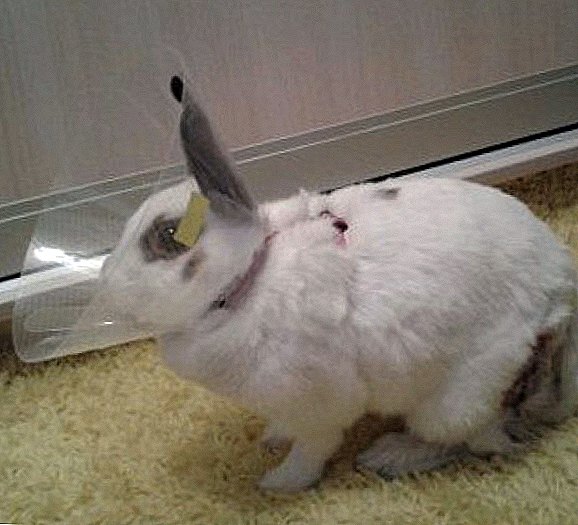 Mite - arthropod being, belonging to the largest group in the class of arachnids. Today there are about 54,000 species. Some of them are parasitic creatures on cats, dogs, rabbits and other animals. They feed on dead skin particles.
Mite - arthropod being, belonging to the largest group in the class of arachnids. Today there are about 54,000 species. Some of them are parasitic creatures on cats, dogs, rabbits and other animals. They feed on dead skin particles.
In our article we will talk about skin parasites of rabbits. The products of vital activity of ticks are very unhealthy for the eared ones, therefore it is necessary to diagnose the ailment in time and take measures to eliminate it so that the life of the animal is not in danger.
Pathogen, ways of infection and symptoms
There are three main types of ticks, most often bothering rabbits:
- fur;
- earplug;
- subcutaneous.
Fur mite
Pathogen Cheyletiella spp. - small oval mite. The size of an adult individual is about 0.385 mm in length. The buccal part of the body is clearly separated from the rest of the body and has large tentacles at the sides. The front pair of limbs is significantly removed from the back. Dorsal shields yellowish white. The parasite lives on the skin and feeds on blood, secretions from sweat and sebaceous glands.  The route of infection is not yet fully understood. It is assumed that the tick is transmitted:
The route of infection is not yet fully understood. It is assumed that the tick is transmitted:
- from a sick animal to a healthy when in contact, especially when crowded;
- from the grass with which the sick animal came in contact;
- from the litter on which the eared patient was sitting;
- flies, fleas, lice are able to carry the pathogen;
- from the owner if hygiene standards are not met.
Symptoms:
- redness and hardening of the skin at the site of the bite;
- rolling fur into clumps;
- the appearance of white dandruff;
- itching;
- rash;
- hair loss (with a strong defeat).
Important! The spread of the disease, as a rule, begins with the tail and at the initial stage can practically not manifest itself.
Subcutaneous (scabies)
Pathogen Sarcoptes scabiei (itch itch) - intradermal parasite of white or yellow-white color. The male is no more than 0.23 mm in length, and the female is 0.45 mm. Have a wide oval body in the fold, not divided into segments. On the part of the legs of the sucker, the rest - with bristles. Eyes are missing. With the help of the gnawing-sucking mouth apparatus, they make passages in the skin and live there. They feed on blood.  Path of infection:
Path of infection:
- from a sick rabbit (during mating, with crowded content, from mother to children when feeding);
- through objects contacted by patients with agricultural or wild animals;
- from a person (carries on clothing, items eared).
Rabbits are often subject to attacks by small parasites. Learn how to get rid of fleas from these animals.Symptoms:
- itching (eared combing harassing places);
- hair loss in places of scratching;
- dry skin or with a purulent crust;
- loss of appetite.
 Most often, the parasite attacks the rabbit's muzzle (nose, ears, eyes). It is these places and begins to comb the animal.
Most often, the parasite attacks the rabbit's muzzle (nose, ears, eyes). It is these places and begins to comb the animal.Did you know? Psoroptes cun. lag behind in development from males for 2-3 days. Being at the fourth stage of development (nymph of the second stage), they mate with males, and when they reach the last stage (puberty), they are fertilized by the sex cells left by the male.
Ear mite
Causative agent Psoroptes cun. - oval mite 0.5-0.9 mm long. Has a yellow or dark yellow color. The adult is endowed with four pairs of legs. Eggs are laid on the surface of the rabbit's ear skin, fixing the clutch with uterine secretion. Females are able to live outside their host for about 24 days. They die at negative temperatures, and instant death occurs in water at a temperature of + 80-100 ° C.  Path of infection:
Path of infection:
- by direct contact of a sick individual with a healthy one;
- through the litter;
- through eared care items;
- from the owner (with clothes);
- from mother to baby rabbits.
We recommend that you familiarize yourself with the diseases of rabbits that may be dangerous to humans.
Symptoms:
- combing the ear;
- there is a crust of ichor in the auricle;
- ears covered with gray crust;
- brown sulfur lumps accumulate in auricles.
Most often the disease progresses in the winter-spring time, when the body of rabbits is weakened.
Video: A simple way to treat rabbit ear mites
Diagnostics
Ear tick can be seen under a magnifying glass. To inspect the animal, it is necessary to equip with a magnifying glass, petroleum jelly, a tool that can be scraped with glass. Taking a scraping from the affected area, place it on a piece of glass on which Vaseline, preheated to 40 ° C, has been applied. Examine the sample under the magnifying glass. If you see a lot of small yellow insects, then your pet attacked a tick.
In the laboratory, a specialist also takes a scraping from a rabbit's auricle and studies it with modern equipment. Further, a cytological examination, examination of the middle ear with an otoscope, X-ray or CT can be performed.
Read about the most common eye and ear diseases in rabbits.
Itch mite gives characteristic symptoms and the presence of small bumps on the skin, which eventually transform into bubbles. When they burst, watery fluid is released. Drying, it turns into a crust or scabs.  In the clinic, a veterinary specialist will make a scraping of the damaged area of the skin and examine it under a microscope, having previously treated it with an aqueous solution of potassium or sodium. If the eared catches a scabies mite, then the parasite and its eggs will be visible under the magnification.
In the clinic, a veterinary specialist will make a scraping of the damaged area of the skin and examine it under a microscope, having previously treated it with an aqueous solution of potassium or sodium. If the eared catches a scabies mite, then the parasite and its eggs will be visible under the magnification.
Fur tick can be found on the fur coat of the crawl during the inspection. It can be seen with the naked eye on the fur of any color.
What to treat and how to treat a rabbit tick
Treatment should begin only when you are sure that your pet has been hit by a tick, and not another disease, and after the parasite has been established. But it is impossible to delay, since the parasite is a danger to the life of the animal.
Veterinary drugs
 Itch mite is treated with acaricidal ointments: sulfuric, sulfuric tar, Yam ointment, birch tar, sulfur powder. If the affected area is extensive, then it is necessary to bathe the patient in a warm solution (+39 ° C) of one percent chlorophos. The solution is not washed off, and the animal must be dried after bathing so that it does not lick the wool. It is advisable to wear conical collar. You can do without swimming. In this case, the rabbit is sprayed with a 2% chlorophos solution or a 0.1% butox solution, alternating with a 0.3% ASD-3 emulsion.
Itch mite is treated with acaricidal ointments: sulfuric, sulfuric tar, Yam ointment, birch tar, sulfur powder. If the affected area is extensive, then it is necessary to bathe the patient in a warm solution (+39 ° C) of one percent chlorophos. The solution is not washed off, and the animal must be dried after bathing so that it does not lick the wool. It is advisable to wear conical collar. You can do without swimming. In this case, the rabbit is sprayed with a 2% chlorophos solution or a 0.1% butox solution, alternating with a 0.3% ASD-3 emulsion.
From ear tick used such drugs:
- Ivermectin is an injectable drug, administered once under the skin in a dosage of 0.2 g per 1 kg of animal weight.
- Stronghold is applied to the withers once in a dosage of 6 mg of selamectin per 1 kg of weight, which is similar to 0.1 ml / kg of a 6% solution and 0.05 ml / kg for 12%.
- Butox-50. One ampoule of the drug is diluted in a liter of water. This solution is sprayed on the ears of the animal. Repeated therapy is carried out in 10 days.
If there are pockets of severe inflammation and itching, then help relieve irritation: ryan, ribotan, aspirin.
It is interesting to know how many years rabbits live at home.
Folk remedies
 The ear mite is treated with camphor oil and turpentine. Oil is collected in the syringe and injected into the auricle. Excess promakatsya napkin. The same method is used for processing with turpentine, but it must first be diluted with vegetable oil (2 parts oil and 1 part turpentine). If necessary, the procedure is repeated after 2-3 weeks.
The ear mite is treated with camphor oil and turpentine. Oil is collected in the syringe and injected into the auricle. Excess promakatsya napkin. The same method is used for processing with turpentine, but it must first be diluted with vegetable oil (2 parts oil and 1 part turpentine). If necessary, the procedure is repeated after 2-3 weeks.
At the initial stage we apply a solution of iodine, alcohol and vegetable oil. The components are mixed in equal shares. This solution is instilled into the ears. The scabs and crusts formed on the skin are softened with the help of warm vegetable oil and a mixture of glycerin and iodine (4: 1). Lubricate wounds need daily.
Preventive measures
- Regularly inspect animals (at least 2-3 times a year).
- Disinfect the instrument and cells with antiparasitic agents at least twice a year.
- Having bought an animal, place it in quarantine, isolating it from the rest.
- Noticing the signs of the disease in one individual, urgently isolate it from the rest.
- Isolate the rabbits from potential carriers of ticks (homeless cats, dogs, rats).
- If the female has to bring posterity the other day, examine her for the presence of parasites.
- Treat the sick rabbit with gloves only.
Did you know? The rabbit can reach speeds of up to 56 km / h while the hare can reach 72 km / h.
Can I eat infected rabbit meat
If the treatment of the rabbit from ticks was successful and quarantine was sustained, then its meat is usable. Otherwise, it is undesirable to consume contaminated meat.  Identify the tick in a pet as early as possible. After all, the parasite not only delivers a lot of inconvenience to eared, but also harms its health. A neglected disease can lead to irreparable consequences, including death.
Identify the tick in a pet as early as possible. After all, the parasite not only delivers a lot of inconvenience to eared, but also harms its health. A neglected disease can lead to irreparable consequences, including death.












